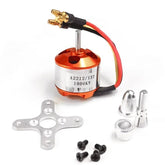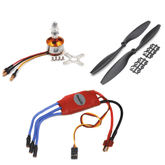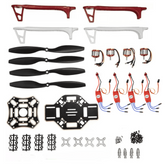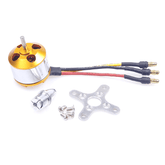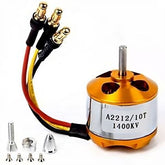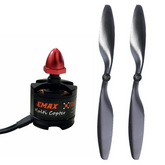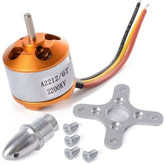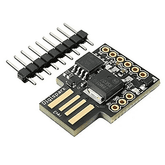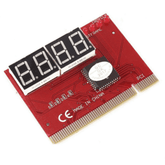Drone Motor – Where to Begin?
Summary
Do you want to unlock the Secrets of Drone Motors: From Brushed to Brushless and Beyond? Did you know that the heart of your drone's performance lies in its motor? Understanding the working of drone motors, including the differences between brushed and brushless models, is key to maximizing flight efficiency and achieving peak performance. This comprehensive blog covers motor sizing, identification, mounting patterns, thrust-to-weight ratio, KV ratings, efficiency, and current draw. Whether you're a seasoned pilot or just starting out, this blog is a must-read for anyone looking to elevate their drone game.
Introduction
When it comes to drones, the motor is one of the most important components for keeping these flying machines airborne. Motors play a vital role in propeller rotation and powering batteries that drive forward motion.
The speed and power of your drone depends on its motors; so choosing high-quality ones is critical to ensure long life and efficient flight performance.
High thrust brushless motors are usually preferred as they offer great efficiency over time without compromising overall quality or reliability.
In addition, you should also take into consideration other factors such as weight capacity when selecting a motor type for your drone application requirements - this will help determine how much load your craft can carry during takeoff!
Ultimately, there’s no right or wrong choice when deciding which motors best suit our needs – however by doing some research about what types are available in today's market we can make sure we pick the best option for us with customers satisfaction guaranteed everytime!
The choice of electric drone motors has a great influence on the flight characteristics of the drone. Small differences in motor design have a big impact on multicopper weight, responsiveness, and overall performance.
Before choosing motors, you should at least have a rough idea of the size and weight of the drone you want to build
Some of the most important considerations are:
- Motor weight
- Power (thrust)
- Efficiency (g/watt)
- Torque and response (RPM changes)
read more : Working of A Drone
Visit our Drone Propellers collection page for light weight propellers.
Working of a Drone Motor
A key concept behind how both brushed and brushless DC motors work is electromagnetism. Both designs use electromagnets as a means of converting electrical energy into kinetic energy.
When an electromagnet is charged, it creates a magnetic field. This temporary magnetic field interacts with the magnetic field of the permanent magnets in the motor.
The combination of attractive and repulsive forces of electromagnets or permanent magnets causes the motor shaft to rotate.

What is drone motor?
Drone motors are a type of electromechanical device, typically powered by electricity. They use an electrical current to create motion and spin the propellers on most commercial drones.
Motor characteristics such as power output, weight, size and performance can significantly affect how well your drone handles in different weather conditions or when carrying payloads over long distances.
Different sizes exist from nano-motors intended for very small quadcopters up to more powerful brushless motors designed for larger models that can carry heavier loads.
Selecting the right motor is important since it will determine how much speed and efficiency you get out of your drone setup while also affecting its battery life - making sure you select one suited to both required flight time duration along budget constraints is essential!
read more : Drone motor maintenance
Brushed and Brushless Motors:
There are two main types of motors used for drones, Brushless and Brushed motors. Usually, we use brushless motors on bigger models (such as racing drones, cinematography drones), and Brushed on the micro drones and toy drones.
This guide will talk more about brushless motors as they are the most widely used motors for drone and multirotor applications.

Brushed Motors:
The inner working of the brushed motor is back to that of the brushless drone motor. In brush motors, the stator provides a permanent magnetic field that surrounds the rotor.
The brush motor rotor is an electromagnet influenced by the surrounding stator. A pair of brushes connected to a DC source contacts the commutator at the rotor base.
The collector ring is separated, so its rotation will periodically reverse the direction of current flowing through the rotor, because its rotation causes the collector to reverse its polarity.
The alternation of the collector ring poles results in an uninterrupted rotation of the rotor. The system efficiency is greatly reduced due to the increase In thermal insulation of the internal mechanics it is also possible to reverse the rotation direction of the motor by inverting the polarity of the DC power input.
Brushless Motors:
As the name suggests, brushless drone motors lack brushes. Brushless motors can effectively be divided into two separate components: rotor and stator. The stator is the central part to which the rotor is mounted.
The stator is made up of an array of radial electromagnets that alternately turn on and off to create a temporary magnetic field when current flows through the windings.
The rotor contains a collection of permanent magnets placed near the stator's semi-permanent electromagnets. Although the brushless motor is DC powered, it cannot be driven directly. Instead, the brushless motor is hard-wired to the control electronics, effectively eliminating the need for a brush or commutator.
The life of the brushless motor is excellent because there is no physical contact between the rotor and the stator.
read more : How to build a quadcopter drone at home
Motor Sizing and Identification
The size of a brushless motor is defined by a four-digit code detailing the size of the stator in millimeters, for example:2206
The first two digits of the series define the diameter of the stator, in this case 22 mm. The last two digits describe the height of the stator, the last two in this series are "06" so the stator unit is 6mm high.
The size of the brush motor can be determined through a simpler two-digit system that clearly defines the diameter and height of the outer box in millimeters. Example:
6×15, the first number "6" is the measurement of the diameter of the can and "15" is the height of the can.
Mounting Patterns and Thread Size
Mounting type and thread size depend on motor type and application. The mounting type determines the location of the threaded bolt holes on the motor base.
Each number describes the diameter of a circle whose center is centered on the motor shaft. Usually, four holes are placed along the circumference of the circle, if given two numbers, two holes are placed on each circle.
For example, a 2205 with a 16×19 pitch will have 4 M3 size threaded holes evenly distributed around the circumference of a 16mm circle and a 19mm circle.
Threaded shaft dimensions are provided by the ISO thread index, which describes the outside diameter of the shaft.
220X-240X:
16x19mm is the most used mounting pattern, however, 16×16 is becoming increasingly common. The thread holes are size M3. The thread shaft diameter D = M5.

Thrust to Weight Ratio
Thrust is one of the main factors to consider when choosing a motor. Thrust of a motor is usually measured in grams and varies depending on how fast the motor and the propeller is rotating. Before a multicopter can begin to accelerate, a thrust is required to overcome drag, as well as gravity.
For example, if the total weight of your drone is 1 kg, the total thrust produced by the motor at 100% throttle should be 2 kg or 500 g per motor for a quadcopter and for racing drones, the thrust/weight ratio is much more than normal multi-rotor. For racing drones, the recommended thrust-to-weight ratio is 5:1
If your quad draws a lot of current at high throttle, the maximum discharge rate of your battery must be able to keep up. The battery must also have the capacity to provide the maximum flight time and power all the components simultaneously.
read more : Assembling the DM002 Drone
KV Ratings:
The speed constant (kV) determines the number of revolutions the motor can make in one minute of no load (no propeller) and at a constant current of 1 Volt. Simply, kV is a representation of the rotational speed of the motor.
The kV of the motor is determined by the magnetic field strength at the stator and the number of turns in the coil.
Motors with lower kV are best suited for efficient drive of heavy-duty propellers. High kV motor optimized for light propellers.
For example, if you choose a 1000KV motor and use a 12V lipo battery for power, the total RPM will be 1000*12=12000 After installing the propeller in the motor, the rpm decreases due to the resistance of the air.
The higher KV motor rotates the propeller faster and can draw more current. Therefore, we tend to see larger rotors used with low KV motors, while smaller, lighter blades are better suited to high KV motors.
If we combine larger propeller with high KV motor, more torque will be required to spin faster. While generating the required torque, it will draw more current and generate too much heat. This overheating can also damage your motor.
Motor efficiency is usually calculated by dividing thrust by power at 100% throttle, measured in grams per watt (g/w). The higher this number, the more efficient the motor.
It is important to consider efficiency across the entire throttle range, not just at the top end. Some motors can operate efficiently at low rpm but can lose efficiency by pulling currents higher and higher as they reach their limit.
Another good way to gauge efficiency is to use "grams per amp" (gain/current). In general, the greater the thrust generated, the greater the current consumed to produce that thrust, so motors with high thrust and low current are preferred. Inefficient motors generate too little thrust or draw too much current.
Each responds differently to different propellers, choosing your propellers carefully is key to balancing thrust and efficiency. Efficiency and current affect your battery choice. An efficient motor with large currents can overuse your battery and cause power outages.
read more : How to build a quadcopter drone at home
How to calculate drone motor thrust
Calculating drone motor thrust can be an important step in ensuring the successful stability and performance of a drone.
The accurate calculation will enable pilots to find the appropriate propeller size for their chosen motors, as well as make sure all components are working together correctly.
The equation used to calculate a motor’s thrust is simple but does require some understanding of basic physics concepts such as force, acceleration, mass and gravity.
To begin with, you must understand your environment; that includes details about altitude (air density) and temperature conditions at the time when motor testing occurs or while flying since this variable greatly affects propulsive forces generated by any given piece of equipment according to Newton's second law:
Force = Mass x Acceleration (F=ma). Having these two pieces of information handy allows us to get started with calculations using power equations derived from propulsion theory where Thrust = Power/Velocity ((T=(P-v)/2).
When calculated properly it should yield enough output numbers which then need to be checked against manufacturer specs provided on respective websites or product packages before use.
Lastly, once proper verification has been done one needs to compare actual vs. projected results - if they differ more than 40% which amounts to reasonable inconsistencies it may indicate there is something wrong with your setup or perhaps parts involved have suffered damage during the transportation process hence replacement might be needed to resolve the issue.
Following the above steps would help anyone avoid dangerous situations potentially caused by incorrect assumptions made regarding system performance characteristics upon purchase first place so please make valid measurements each time fly safely!
read more : Affordable drone batteries
How to choose drone motor
Choosing the right drone motor for your project can be a daunting task. With all the different makes and models available, it's hard to know what is best suited for your specific needs.
But don't worry- with just a few considerations in mind, you'll have no trouble picking out exactly which one will fit perfectly into your setup!
First, think about power output capabilities: determine how much lift must be generated by each propeller during flight and make sure that the possible motors are capable of providing this amount of thrust or allowable load limit prior to committing to purchase any model(s).
Also consider motor size: most drones require multiple electric motors mounted on their frames; select ones that provide ample airflow while still being small enough not to disrupt overall lipo battery weight balance or manoeuvrability.
This combination minimizes drag during flights so ensure you review ratings such as KV (RPM per volt) when making decisions here too.
Next consider performance features such as torque/load current rate since they play key roles in controlling speed range plus stability under certain conditions like wind gusts etc., along with the component's durability over time –
meaning look at both brushless vs. brushed varieties depending on application use type – longer lasting brushless types are preferred when needing more consistent speeds throughout but might cost more than standard styles up front yet prove well worth additional money spent later down line due regular maintenance avoidance via greater longevity abilities built into them compared against others variants representatively speaking.
read more : What are drones? A-Z Guide Of Assembly to Flying
Selection Guide Table:

How to fix a drone motor
Fixing a drone motor is no easy task. But, with the right knowledge and tools, anyone can do it! Here's what you'll need:
A good quality Drone Motor – Make sure to choose one that fits your model of drone correctly - if not fitted properly any repairs will be wasted effort; A Phillips Screwdriver and set of Hexagonal Wrenches/Allen Keys for taking apart the Drone components as required; Appropriate Greases & Oils – You’ll need these to lubricant moving parts during reassembly or repair works.
Now onto actually fixing the motor itself- there are several steps involved in this process: Begin by disconnecting all power sources connected to your Motors including Propellers and battery Pack before attempting any fixes on them!
Once disconnected remove (if needed) anything blocking access such as plastic covers from external motors casing - use appropriate sized screwdrivers or Allen keys etc., and take extreme health care whilst handling delicate electronic parts within these exposed motors compartments.
If possible make notes about which screws got removed where so they don’t get mixed up later when putting back together again afterwards at the end stage once repaired correctly.
Then move forward towards the actual repairing stages being careful not to mishandle internal wires/parts throughout each step taken ensuring everything gets tightened securely after their respective operations i.e. cleanings/lubrications etc.
read our blog explaining the drone materials list, provides comprehensive information about drone components and materials required to build a drone.
How to test a drone motor
Testing a drone motor is an important step to ensure its reliability and performance. Professional testing should always take place in order to guarantee that the motor will remain reliable even under heavy-duty conditions.
Here are some steps you can follow when testing a drone motor:
Start by inspecting the parts of your drone, paying special attention to any components that could affect proper operation such as propellers, blades or landing gear.
Make sure all necessary hardware is attached securely before beginning your tests. During this process identify if additional maintenance or repairs need to be completed at once on any worn-out part of the engine assembly prior to proceeding with further measurements.
Assemble and run according to power source for a specified time frame while monitoring speed fluctuations of each pair rotor blade - motors' RPMs must be consistently balanced within set limits across both clockwise and counterclockwise rotation cycles otherwise higher vibration levels might occur during use causing overall malfunctions due rapid wear out.
Perform load test - isolate the relevant electronic component from the main circuit then apply electrical stimulus up limit allowed boundaries, record the amount of current being drawn which should match manufacturer's specifications; lastly verify linearity response rate different voltage values and adjust accordingly until desired outcomes achieved.
Stop all pressure points stress related activities assess thermal variation parameters controlling heat dissipation prevent system critical malfunctioning caused overheating issues.
Visit our Lipo Batteries collection page for Powerful Batteries.
read more : Upgrade Your Control: Best Drone Remote Controllers
Advanced Motor Selection:
Most quadcopter motor specifications are not mentioned by the manufacturers and can only be found through more testing and analysis.
- Torque
- Load
- Response Time
- Propeller size and Prop balancing
- Temperature
- Vibration and balance
- Motor Movements
- Motor Build material
Conclusion
In this blog post, we have learnt that the drone's performance depends on the selection of the right motor! If you are a professional pilot or just looking for an upgrade.
From brushless to brushed, we have explored the different types of motors and their benefits. So don't wait, take your drone to new heights with the power of a top-performing motor. Find the perfect drone motor for you today!
If you appreciate our work don't forget to share this post and leave your opinion in the comment box.
Please do check out other blog posts about Drone transmitter and receiver , Drone Part List , Best Flight Controller for Drone and WHY DRONE IS MORE THAN A HOBBY
Make sure you check out our wide range of products and collections (we offer some exciting deals!)



